
Huntsman spiders, members of the family Sparassidae, are known by this name because of their speed and mode of hunting. They are also called giant crab spiders because of their size and appearance. Larger species sometimes are referred to as wood spiders, because of their preference for woody places. In southern Africa the genus Palystes are known as rain spiders or lizard-eating spiders.. Commonly, they are confused with baboon spiders from the Mygalomorphae infraorder, which are not closely related.

The Araneomorphae are an infraorder of spiders. They are distinguishable by chelicerae (fangs) that point diagonally forward and cross in a pinching action, in contrast to the Mygalomorphae, where they point straight down. Araneomorphs comprise the vast majority of living spiders.
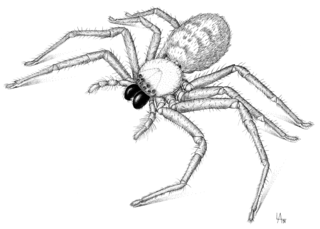
Delena cancerides, the communal huntsman, flat huntsman or social huntsman, is a large, brown huntsman spider native to Australia. It has been introduced to New Zealand, where it is sometimes known as the Avondale spider. This was the species used in the Australian movie Napoleon and widely in Arachnophobia, and all films depict them as having a deadly venomous bite, but they are generally considered harmless to humans in real-life. It was first described by Charles Athanase Walckenaer in 1837.
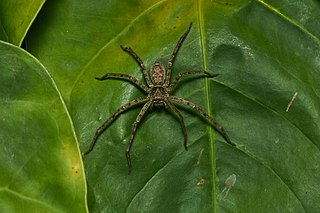
Heteropoda venatoria is a species of spider in the family Sparassidae, the huntsman spiders. It is native to the tropical regions of the world, and it is present in some subtropical areas as an introduced species. Its common names include giant crab spider, pantropical huntsman spider or cane spider.
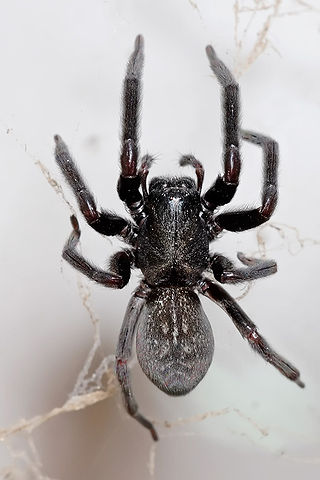
The black house spider or common black spider is a common species of cribellate Australian spider, introduced to New Zealand and Japan. A closely related species, Badumna longinqua, the grey house spider, has a similar distribution, but has also been introduced to the Americas.

Micrommata virescens, common name green huntsman spider, is a species of huntsman spiders belonging to the family Sparassidae.

Missulena occatoria, known as the red-headed mouse spider, is a species of spider found in Australia, from open forest to desert shrubland. It is the most widely distributed Missulena species, occurring throughout mainland Australia. This is possible because the spiderlings disperse via wind (ballooning). Normally this only occurs with araneomorph spiders, mygalomorph spiders normally disperse by walking. Missulena venom may be very toxic, but few cases of serious envenomation have been recorded. Most recorded bites only caused minor effects, with Australian funnel-web spider antivenom having proved effective as a treatment.
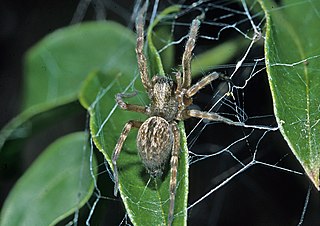
Badumna is a genus of intertidal spiders that was first described by Tamerlan Thorell in 1890. They are harmless spiders that can be found around human structures and buildings. The most well-known species is B. insignis, also known as the "black house spider" or "black window spider".

The giant huntsman spider is a species of the huntsman spider family Sparassidae found in Laos. It is considered the world's largest spider by leg span, which can reach up to 30 cm (1 ft).

Heteropoda davidbowie is a species of huntsman spider of the genus Heteropoda. It was described from the Cameron Highlands District in peninsular Malaysia and named in honour of singer David Bowie.

Holconia is a genus of Southern Pacific huntsman spiders that was first described by Tamerlan Dahls Thorell in 1877. It was branched from Isopeda in 1990.
David B. Hirst is an arachnologist previously based at the South Australian Museum in Adelaide. He left the Museum on 22 February 2011. He has described more than 40 species and genera in the huntsman spider family, Sparassidae, and was regularly called on by New Zealand authorities to identify huntsman spiders that entered their country.
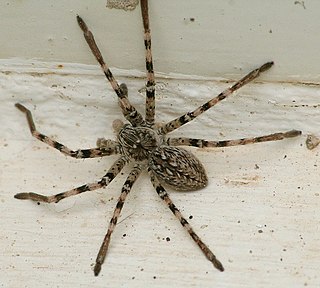
Eusparassus is a genus of huntsman spiders, known as the stone huntsman spiders, it was first described by Eugène Louis Simon in 1903.

Missulena insignis, commonly known as the lesser red-headed mouse spider, is a species of spider belonging to the family Actinopodidae native to Australia. The species name is derived from the Latin insignis "mark".
Peter Jäger is a German arachnologist, and current Head of Arachnology at the Senckenberg Research Institute and Natural History Museum in Frankfurt, Germany.

Beregama is a genus of South Pacific huntsman spiders that was first described by D. B. Hirst in 1990.
Keilira is a genus of Australian huntsman spiders that was first described by D. B. Hirst in 1989. As of September 2019 it contains two species, found in South Australia and Victoria: K. sokoli and K. sparsomaculata.
Uaiuara is a genus of huntsman spiders that was first described by C. Rheims in 2013.
Deelemanikara is a monotypic genus of east African huntsman spiders containing the single species, Deelemanikara christae. It was first described by Peter Jäger in 2021, and it has only been found in Madagascar.
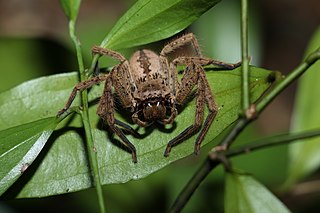
Beregama cordata, sometimes called the fire-back huntsman, is a species of spider endemic to Queensland and New South Wales, Australia. It is a member of the genus Beregama of huntsman spiders.















